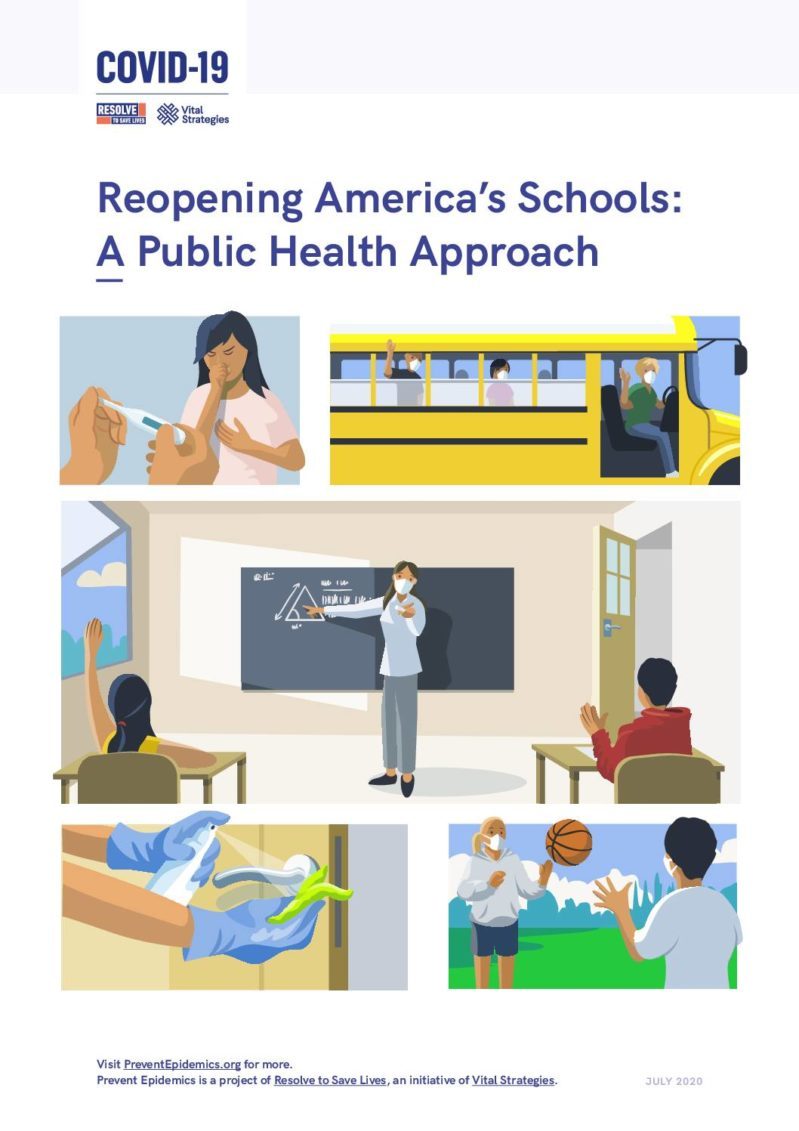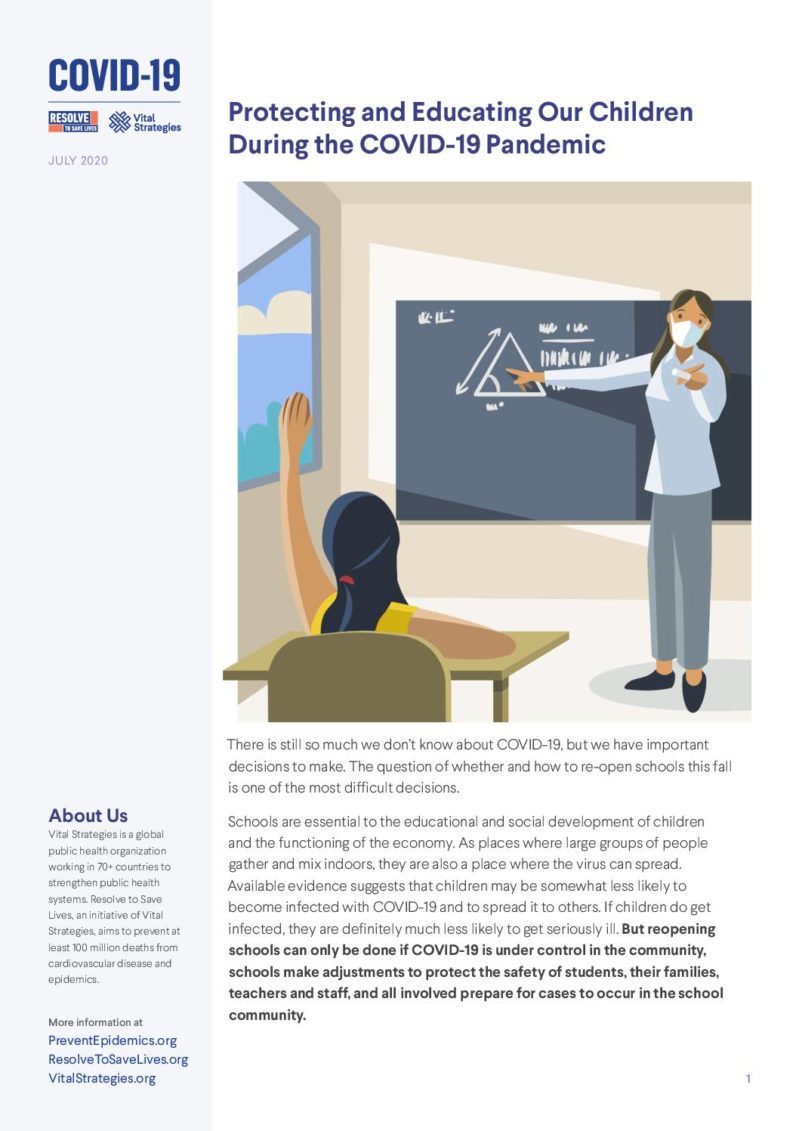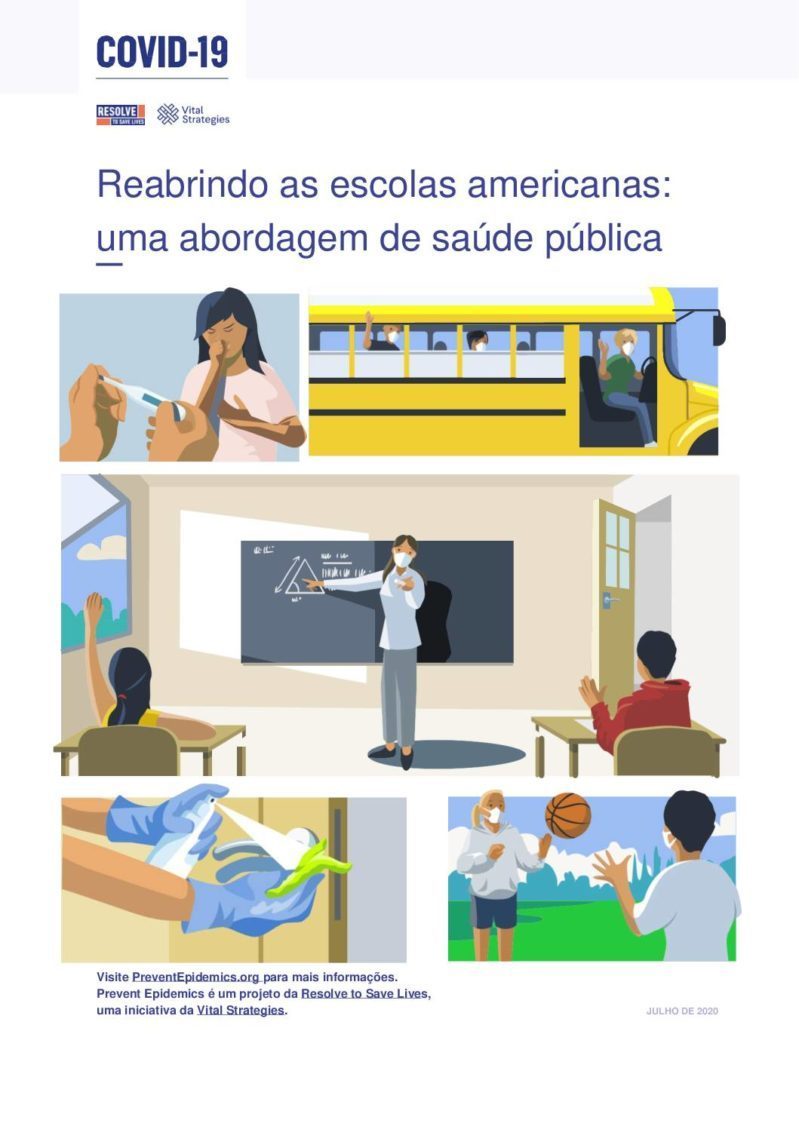Schools play an essential role in the educational and social development and in the functioning of the economy. We need to reopen schools this fall, but we have to do it carefully, prioritizing the safety of students and their families, teachers and staff, and the broader community. Not every school will be able to reopen, and almost every school will have to make changes — but we can provide millions of schoolchildren a safe, quality education if we follow common-sense guidelines.
Public health expertise can help staff and educators reduce risk. In particular, staff and educators should review CDC guidance, and calibrate their precautions according to the severity of the local epidemic, tightening restrictions when there is community spread and only relaxing them if there are few or no cases. In addition to the spread of the virus in the community, staff and educators must also consider how many people gather together, in what proximity, over how much time, with what level of ventilation, and with what proportion wearing masks.
Frequently Asked Questions from K-12 Staff and Educators
This document addresses some of educators’ frequently asked questions. The bottom line is that there is no route to zero risk of Covid in the near future. If we follow the best available information, we can open sooner and safer.
Can a school test all students and faculty and then, if they are free of COVID-19, proceed as normal?
Tempting though it may be to consider a school a bubble, there is no practical way to keep the virus out completely. Even in a school that tests every student, staff member, and educator daily, some tests would be falsely negative, and a previously exposed person could become infectious in the hours between testing and going to school. Complete and frequent testing of staff and students is difficult, expensive, and of unproven value. Schools must function as if the coronavirus could arrive at any moment and operate in such a way as to reduce transmission when it does. CDC has guidance for administrators on testing in K-12 schools and institutions of higher learning .
Should students who live with elderly family members or other medically vulnerable people attend school?
Parents and students will have to weigh the risks carefully and consider which they can reduce. If students can stay separated from medically vulnerable household members by limiting interactions and using a different bathroom, they may be able to attend school while limiting the risk to their family. On the other hand, in the case of an older child who can attend school remotely, it may be preferable to forgo in-person attendance and reduce the risk of spread in the home. The higher the incidence of COVID-19 in the community, the greater the risk.
Should older or medically vulnerable staff take special precautions?
Unless there is very little or no transmission of COVID-19 in the local community, older staff and educators and those who are otherwise vulnerable to severe disease should be offered reasonable accommodation to work remotely. This is the cost of doing business in the age of COVID-19. The CDC has published guidance about groups of people who should take extra precautions.
To what degree should schools incorporate distance learning?
Students vary in their ability to learn remotely. High school students may be more adaptable to online learning, whereas students in elementary or even middle school may learn better in person. Educators will have to weigh direct (COVID-19) and indirect (non-COVID-19, such as food insecurity) risks to health, the level of community transmission, and the educational and other costs of replacing in-person classes with remote learning sessions. In response to the pandemic, there are many new online resources for distance learning, for example from the Smithsonian , the U.S. Department of Education , and Google . Schools should have plans in place to shift students from in-person to online learning as needed, if local guidance is to close schools or if individual students need to remain home. In advance of the academic year, schools may also choose to offer families a choice between in-person and virtual education.
What steps can school buses take to operate safely?
When possible, school buses should keep their windows open to increase ventilation. Interiors should be disinfected regularly and modified to reduce the need for touch e.g., with doors that are opened by the driver, not the students. The driver and all riders should wear masks, and, ideally should have assigned places on the bus, one person per seat and skipping rows (though this may not always be feasible). The CDC has prepared additional guidance for bus transit operators .
What policies should schools adopt about wearing masks?
Face coverings help reduce disease transmission. The more people wear masks, the better. Although it may be challenging to wear masks all day (particularly for younger children), school staff should wear face coverings and students should be taught to wear them and encouraged to do so, particularly when physical distancing is not possible. Teachers with young students or students with disabilities may opt to use masks with clear “windows” that allow pupils to register their facial expressions and read their lips. Schools can also offer “mask breaks” throughout the day, as long as students are physically distanced, ideally outside. Face coverings should not be placed on children younger than two years old, anyone who has trouble breathing, or anyone unable to remove the covering without assistance. The Minnesota Department of Health has created some materials to help explain and make masks , and the Nemours Foundation has developed some strategies for for helping kids get used to wearing masks .
What are strategies for ensuring students observe physical distancing requirements?
There is no definitive appropriate minimum physical distance—six feet is safer than 3 feet, but both are safer than no distancing. People should aim to physically distance at least 6 feet. To help students maintain physical distancing, schools can install visual cues such as informational signs and markings on the ground to indicate appropriate spacing. Schools can also emphasize distance messaging thorough videos, public announcements, and positive reinforcement. Making hallways and parts of classrooms or larger rooms one-way for foot traffic may also reduce risk of spread. For younger students, educators have developed games using hula hoops, measuring tapes, and balls to teach physical distancing in a fun and engaging manner.
Can classrooms be rearranged to reduce transmission?
Instead of organizing students in a circle or in small groups, they should be seated in rows, appropriately physically distanced, and facing the same direction. Teachers should also consider assigning seats so students are consistently in the same orientation and proximity to one another—old fashioned arrangements, but a practical way to reduce risk of spread. If windows can be open or air systems set to increase the amount of outside air, this may further reduce risk.
Should teachers explore alternatives to holding class indoors?
If conditions allow, it is much safer to hold class outdoors. Doing so reduces the risk of transmitting the virus through the air and through contaminated surfaces. To spread students out further, schools may consider repurposing well-ventilated auditoriums and gymnasiums for additional classroom space, and reaching out to community partners about unused local spaces.
Should the structure of individual classes be changed in light of COVID-19?
To the extent possible, students should remain in small groups rather than mixing and forming different class units throughout the school day. This will limit the potential of spread from any infected student to a smaller number of students and staff, and minimize disruption to the entire school if someone becomes infected. The Brooklyn Lab Charter School developed toolkits on how to modify classrooms and schedules to reduce risk .
Do educators need to use special shared equipment and supplies?
To reduce the risk of transmitting the virus via a surface, classes should reduce their reliance on common supplies and equipment. For example, students should use individually assigned art supplies rather than sharing them. In all classes, shared equipment should be disinfected after each use.
What other steps can schools take to reduce the risk of COVID-19 being transmitted via surfaces?
Schools can adopt simple practices and changes in physical design to reduce risk of transmission. Students should be required to perform hand hygiene (either hand-washing or using alcohol-based hand sanitizer with greater than 60% ethanol) on arrival at school, before eating, upon putting on or removing their face coverings, and at dismissal—and schools should ensure they have sufficient supplies of hand soap and hand sanitizer to meet that need. Educators should alter spaces to reduce the number of surfaces that multiple people need to touch, for example by propping doors open so they don’t need to be handled. And surfaces that are touched commonly should be disinfected regularly (e.g., every two hours during the school day and at the end of the day). Even if there is no COVID-19 in the school, doing this will reduce spread of other illnesses, such as the flu, and reduce absenteeism.
Are there other important measures schools should consider to prevent mixing and congregating of students and faculty?
The CDC advises schools to stagger pick-up and drop-off times to reduce crowding and mixing at the beginning and end of the day. Schools may also want to consider moving to a split-shift schedule and staggering school days or weeks entirely, with half the students attending in-person on even days or weeks and the other half following the reverse schedule. It’s important to consider closing all common staff break areas and keeping staff from interacting unless they can physically distance.
Can schools safely offer recess and physical education?
Physical activity is important to maintaining health and wellbeing—but it can be difficult to maintain physical distance, and breathing hard may increase the risk of viral transmission. To reduce risk , students may play outdoors in smaller groups, masked and observing physical distancing guidelines. Schools should also consider limiting physical education to lower-risk activities (e.g., running) rather than higher-risk activities (e.g., wrestling). Smaller children may need to be supervised to reduce risky contacts. One school in China used a form of cardboard tube hat to remind students to stay apart! Schools should also consider closing shared recreational facilities and instead have instructors come to classrooms to limit mixing. The Society of Health and Physical Physical Education Instructors (SHAPE) America has created resources for physical education .
How should performing arts groups rehearse and perform?
In light of evidence that singing may contribute to COVID-19 transmission, the National Federation of State High School Associations issued guidance that discourages indoor group or ensemble singing until mitigation techniques have been tested and proven effective and recommends that instrumental groups be limited in size to meet physical distancing requirements. The American Choral Directors Association has issued guidance recommending that choirs rehearse and perform in small, physically distanced groups, and outdoors if possible.
Can schools continue to offer field trips, special assemblies, and other extracurricular activities?
Schools have to weigh the educational and social benefits of such activities against the increased risk of disease transmission. Even an outdoor activity might require travel to and from in a small shared vehicle. And some team sports may be too risky. Generally, schools should suspend activities that require unnecessary intermingling, although it may be reasonable to make some exceptions, for example a walking or cycling trip that starts at the school. Outdoors is far, far safer than indoors.
What safety precautions should cafeterias observe?
There is currently no evidence that COVID-19 is spread through food, but sharing plates and utensils and congregating in large groups increases risk. Cafeterias should replace buffet-style offerings with individually-plated meals or grab-and-go options and use disposable dishware if at all feasible. Students should eat in classrooms rather than in large common areas. Schools should consider staggering mealtimes to limit the number of students congregating at any given time, and can also install physical cues such as markings on the floor and signs on the wall to guide appropriate physical distancing for students waiting in line to pick up food. Frequently touched surfaces should be disinfected often. The CDC has prepared additional guidance specifically for school nutrition professionals, who should wear face coverings, practice physical distancing and routinely clean and disinfect kitchen surfaces .
Can schools welcome outside visitors as normal?
No. Schools should discourage any nonessential visits and require everyone who enters the school—parent or other relative, delivery person, maintenance worker—to wash hands or use hand sanitizer and wear a face covering. Temperature checks for visitors are less likely to be a useful screening tool, although some schools may choose to conduct them.
What should a school do if a student or staff member tests positive for COVID-19?
Administrators should prepare for infections in their staff and student body with detailed and rehearsed protocols, and should designate a COVID-19 space separate from where routine medical care is provided. Any sick people should be advised to stay home until they meet CDC’s criteria to discontinue isolation , and people who had close contact with an infected person should quarantine for 14 days after the last possible exposure. This underscores the importance of observing physical distancing measures, because doing so will prevent the disruption of many people needing to be quarantined. The CDC has developed additional guidance for preparing when someone gets sick .
What policies can a school adopt to encourage sick students and faculty to isolate at home?
When an infected person stays at home, it helps protect the entire school community. Schools should take steps to make this as easy as possible for students and staff members who feel ill by suspending requirements that students provide doctor’s notes for their absences and by providing all staff with paid sick leave and requiring contracted service providers at the school to provide for paid sick leave. If students need to isolate at home, they should also be provided the opportunity for consistent ongoing education through virtual learning.
Should schools continue to hold in-person classes if there is extensive spread of COVID-19 in the community?
Probably not. When there is substantial disease spread, most or all schools should suspend in-person classes until the outbreak is better controlled. (There is no generally accepted definition of extensive spread. One example would be a threshold of 5% of people tested for the virus found to be infected and the proportion is rising, or more than 10% of tested people are infected, regardless of the trend). Even if children are less likely to spread the virus and to become seriously ill from it, staff will need to travel to and congregate in the school, so continuing school in the face of high community transmission of COVID-19 may be unwise. The CDC has prepared guidance to help weigh the tradeoffs of school closure . Schools should follow guidance from their county and state health and education authorities on whether to continue or halt in-person classes and be ready to shift to online education if needed.
What can staff do to decrease their risk of being infected?
School staff should be protected as much as possible. They should be well equipped to wear face coverings, practice good hand hygiene and physically distance throughout the day. Adjusting floor plans , classroom layouts and student traffic flows that reduce transmission risk by decreasing close interaction, increasing ventilation and creating physical barriers should be considered. Older and medically vulnerable staff should take extra precautions. The highest risk to staff is from other staff, so eliminating common break rooms and ensuring distancing among staff are important steps to increase safety.
Download Resources:
-
Reopening America's Schools: A public health approach
(275.39 KB)
-
Protecting and Educating Our Children During the COVID-19 Pandemic
(417.69 KB)
-
OpEd: These 8 Basic Steps Will Let Us Reopen Schools
-
Press Release: Health and Education Experts Weigh in on How Schools Can Maximize Health and Safety as They Look to Reopen
-
Media Briefing: Re-Opening K-12 Schools
-
Reabrindo as Escolas Americanas: uma abordagem de saúde pública
Portuguese



